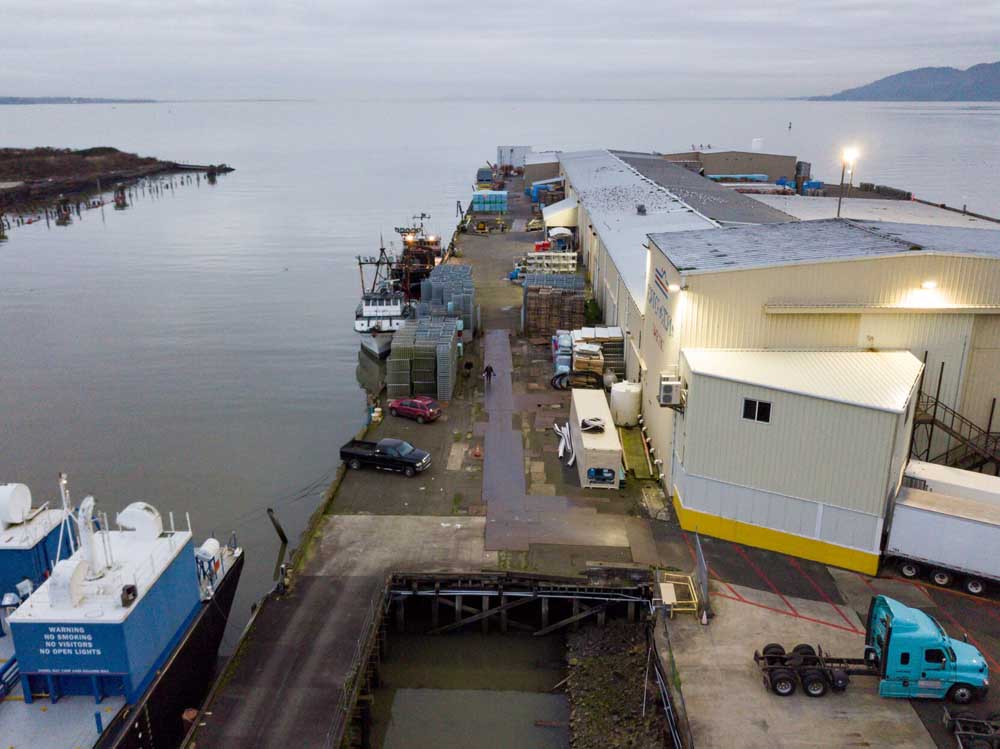Astoria’s Port zeroes in on Pier 2 fixes
Published 12:45 am Sunday, January 31, 2021

- Metal sheets cover sections of the rotting dock at Pier 2 at the Port of Astoria.
Without logs, seafood is the only commodity coming across the Port of Astoria’s docks.
But a patchwork of metal sheets prevents workers from falling through the rotting docks, while a failing seawall threatens the warehouse where hundreds are employed churning out packaged seafood.
With a strategic plan in place and growing trust from government partners, the port is spending more than $240,000 to get a detailed-enough fix for Pier 2’s issues to apply for several large federal grants.
The west side of Pier 2 stretches 800 feet out into the Columbia River. The metal sheet pile seawall holding the pier in is only 8 feet out from the western edge of the seafood processing warehouse.
Matt McGrath, the Port’s deputy director, said the close proximity has caused the two load-bearing walls to bow out, threatening failure.
“We want to move this sheet pile wall out as far as we possibly can, and that’s going to solve a number of our issues,” he said. “One is that you’re not having to worry about any of the load plane from the building causing any failures to the sheet pile wall. Another is that when you move this wall all the way out … to the existing dock line, your maintenance costs basically go to zero.”
What McGrath called the “Cadillac” option could minimize the Port’s maintenance on the dock for 50 to 75 years and solve a major safety issue. The less desirable option is to keep the seawall next to the warehouse and replace the dock on Pier 2, which McGrath said would lead to the same issues in the future.
The Port Commission paid KPFF Consulting Engineers more than $250,000 in 2019 to study the issues with the pier. Last week, the Port Commission approved more than $248,000 for the firm to come back with the most feasible fix and enough specificity to go after federal grants.
“Even though it is a big number, the overall scope of Pier 2 justifies that,” Dirk Rohne, the president of the Port Commission, said of the new contract. “And it’s nice that we’re actually preparing the Port to be able to move forward on this, even though it is a process.”
Shane Jensen, the Port’s grant writer, hopes to go after three large grants through the U.S. Maritime Administration that could fund Pier 2.
The Port Infrastructure Development Program, specifically for Port projects around the U.S., was funded at $225 million in the recent omnibus funding package passed by Congress. The Better Utilizing Investments to Leverage Development grant for various transportation projects received $1 billion, as did the Infrastructure for Rebuilding America grant.
Port staff has estimated $7 million to fix Pier 2. All three federal grants are within a range that could cover the project, Jensen said, but the key is whether KPFF’s report is done soon enough or with enough detail to satisfy the federal agency.
“My understanding is it should be finished in April,” Jensen said. “The three (Maritime Administration) grants are likely to be due in May. So there’s going to be a very tight window.”
“It is important to get these projects and the Port’s needs in front of these agencies,” he said. “So, the fact that it is very unlikely the Port would be awarded all three grants is not a reason to not apply for all three.”
Several years ago, the Port received a $1.5 million state infrastructure grant as part of a $2 million project to repair the west side of Pier 2. Jim Knight, the Port’s executive director at the time, returned the grant to the state after the Port could not come up with the $660,000 local match.
Will Isom, who replaced Knight as executive director in 2019, said Pier 2 has been a source of frustration for the Port since he started with the agency as a staff accountant several years ago.
“We sit there and we talk about Pier 2 west being the highest priority for the Port,” Isom said. “We need to really push on this and make it the highest priority.
“If you look at the Port’s mission, it only mentions a few things. It talks about safety and the environment, and then it also discusses job creation and economic growth. And this project touches all of those things.”






